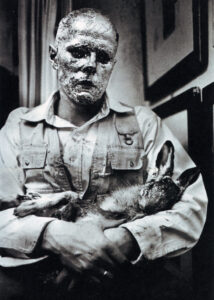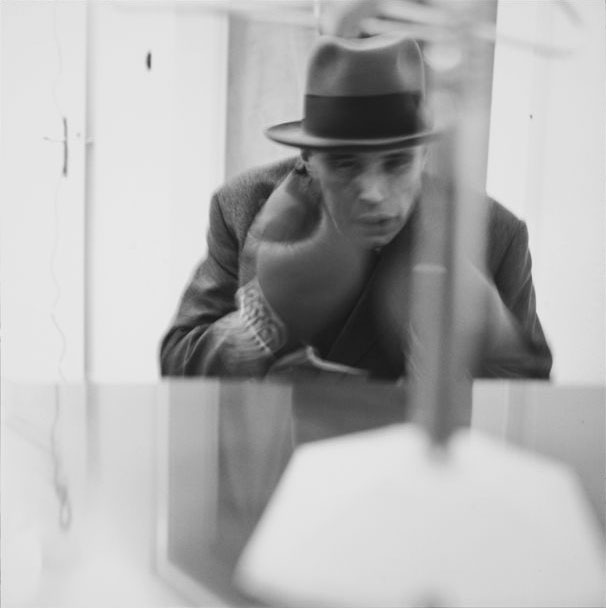Three young artists from the Frankfurter Hauptschule, a German art cooperative, created a made-for-YouTube robbery and art heist prank in late October 2020, ostensibly to raise awareness of Germany’s short but brutal colonial history in Africa. Although originally reported as an actual theft and gifting to Tanzania of one of Joseph Beuys’s “Capri-Batterie”, the video portrayal actually appears to be more about being cool, wearing well-cut khakis, and having a great time in slick airports and posh hotels than it is about correcting past injustices. A subsequent video statement by Tanzanian chief curator of the Iringa Boma museum, Deonis Mgumba, helps to inform and balance the ‘event.’ (See below)

Government building, “Gouvernments-Gebaüde”, Dar es Salaam. Album, title: Zur Erinnerung an Deutsch-Ost-Afrika. S.M.S. Bussard, from 1906 until 1908, Winterton Collection of East African Photographs 32-4-2, Melville J. Herskovits Library of African Studies, Northwestern University, Evanston, IL, USA. Public domain.
The video makes no mention of atrocities committed by Germany in Tanzania during the colonial period. For more on this, see the accompanying article, Humboldt Forum Collaboration with Tanzania.
(If there is a case to be made that the Bad Beuys’ performance art is an absurdist critique of European exploitation, it would be found in the creation of the video itself, not in its ‘message.’ The art cooperative must have spent significant German funds for airfares and other expenses to make a holiday video that shows the ceremonial presentation of a worthless object to a former colony in acknowledgment of the loss of hundreds of thousands of human lives during the time of German colonization.)
The “stolen” artwork replicated a Beuys sculpture made of a yellow light bulb in a socket that is plugged into a lemon. The original work was created in an edition of 200. These lemon and light bulb sculptures were made during the last year of Beuys’s life, while he was living on the Island of Capri in Italy.
The YouTube music video of the pretend heist is called “Bad Beuys go Africa,” and was dedicated to the late performance artist and filmmaker Christoph Schlingensief. The authentic Capri-Batterie was actually in storage at the Oberhausen City Theater, where the prank “theft” took place.

Joseph Beuys, How to Explain Pictures to a Dead Hare, or Wie man dem toten Hasen die Bilder erklärt, performance on 26 November, 1965 at the Galerie Schmela in Düsseldorf, Germany.
The video, set to a cover version of the song “Africa” by the band Toto, first “documents” the theft of the lemon and its yellow bulb. The video then portrays the flight with Capri-Batterie to Africa, and a tour around Tanzania, even a little shopping in the local bazaar. Except for the presentation of the replica Beuys sculpture to Tanzanian authorities and its placement in an exhibition space together with traditional Tanzanian artifacts, the video is similar to other popular travel videos – three minutes and fourteen seconds of we-are-the-world themes with attractive young people and more than a touch of white privilege.
Never ones to miss a cute pun, the Bad Beuys film Capri-Batterie next to a Capri sun juice pouch on the flight to Tanzania, let it ride on the rail of a people mover in an airport, take it dancing at a Tanzanian night club, and dance with it happily in the rain, echoing the song lyrics of “I bless the rains down in Africa.” They even work in a bit of a scene in Disney’s The Lion King in which baboon Rafiki presents Simba the lion cub to the rest of the animal kingdom.
An homage to Beuys it’s not. The pop-culture banality of the Bad Beuys video cannot be compared in any way with the performance works of Beuys himself – always self-focused but at least challenging to the viewer. It’s Disney rather than dead rabbits for the Bad Beuys crew.
Following these jolly adventures, the safari-outfitted activists present the fake Capri-Batterie to authorities at the Iringa Boma Regional Museum and Cultural Center. The museum, in the Southern Highlands of Tanzania, in the Iringa Region, at least is real. There it is placed on display with Tanzanian cultural objects.
A Thoughtful Response from Deonis Mgumba in Tanzania
Three days after the ‘heist’ was widely reported throughout the art world, Deonis Mgumba, the principal curator at the Iringa Boma Regional Museum and Cultural Center, released a video announcing that a replica of Beuys’s work was used in the project and that the real object remained in the back room of the Oberhausen City Theater.
In it, Mgumba speaks about the repatriation of human remains taken from Tanzania and explains that the museum cooperated with Frankfurter Hauptschule in bringing the Capri-Batterie to Africa in order to “raise people´s awareness” and to “trigger the ongoing debate about restitution of different artefacts, ethnographic collections or even human remains, which were taken from different German colonies in Africa.”
Mgumba said:
“You see, we understand, different communities have their different perception about forebears, but for us, we believe, our forebears, they never have their rest, because their remains were taken away. And that’s why we think it´s important to bring them back, to be buried at their home places, because we also believe that – since their remains are not here – there is no existing link between the younger generation and our forefathers. That´s why we see it as an important thing to be done.”
See related article Humboldt Forum Collaboration with Tanzania, Cultural Property News, November 22, 2020
 Documentation of Josef Beuys’ Filtz TV (Felt TV), Author Lothar Wolleh, 1971, Creative Commons Attribution-Share Alike 3.0 Unported license.
Documentation of Josef Beuys’ Filtz TV (Felt TV), Author Lothar Wolleh, 1971, Creative Commons Attribution-Share Alike 3.0 Unported license. 

